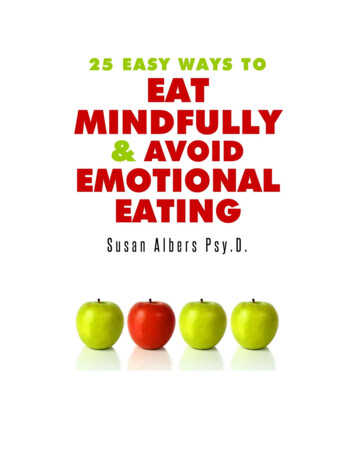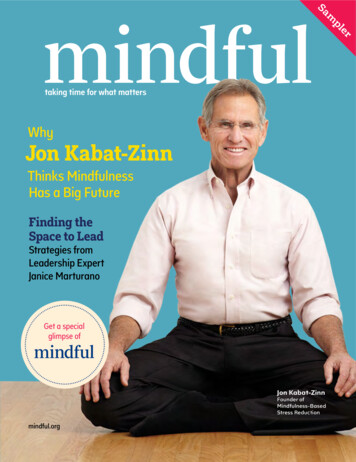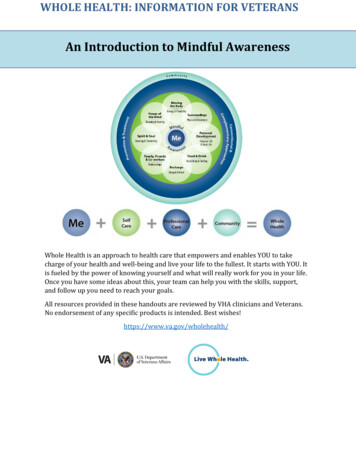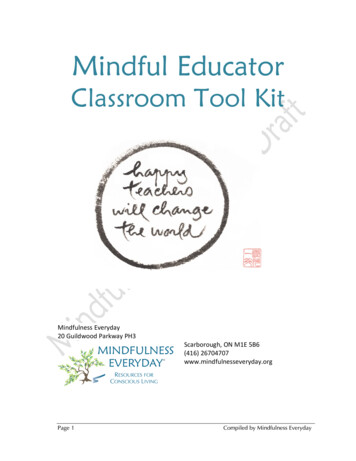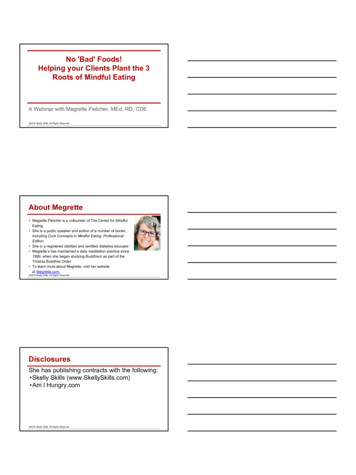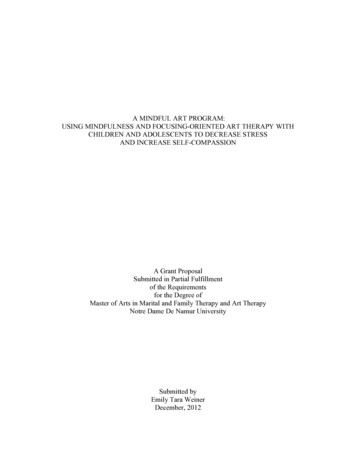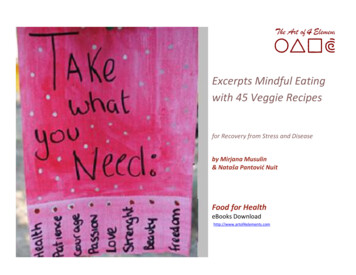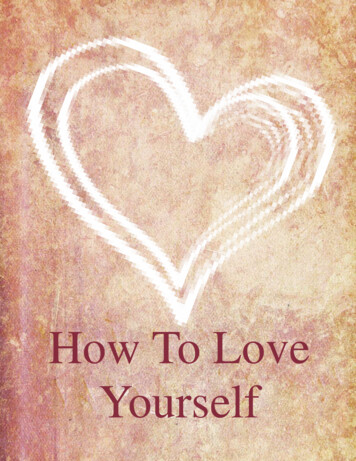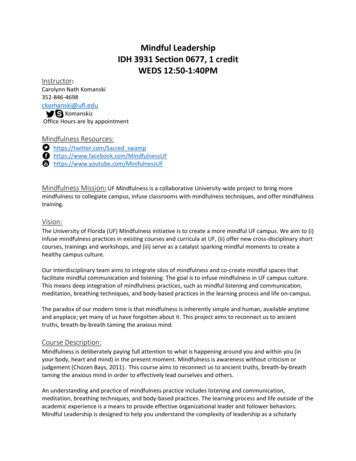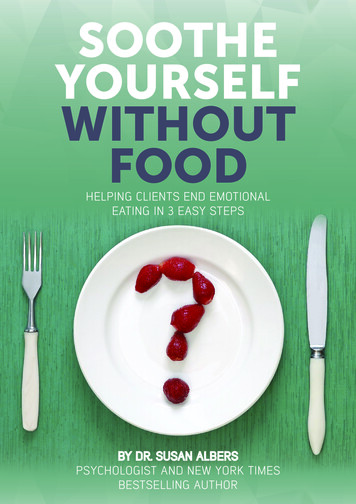
Transcription
SOOTHEYOURSELFWITHOUTFOODHELPING CLIENTS END EMOTIONALEATING IN 3 EASY STEPSBY DR. SUSAN ALBERSPSYCHOLOGIST AND NEW YORK TIMESBESTSELLING AUTHOR
HELLOI’m Dr. Susan Albers, a psychologist at the Cleveland Clinicand New York Times bestselling author of seven books onemotional eating including EatQ, Eating Mindfully, and 50Ways to Soothe Yourself Without Food. For over fifteen years,I’ve been helping people eat more mindfully and get out of theemotional eating cycle. If you’ve opened this guide, it’s likelythat you have patients or clients who come into your officeevery single day asking, “How can I stop emotional eating?”This is a great question! The issue is more complex than onemight think. A client may wish to disengage from emotionaleating and recognize it is a problem but not be able to stop it.This guide will walk you through three easy steps to help clientsend emotional eating. It is based on the suggestions in my newbook 50 More Ways to Soothe Yourself Without Food—thesequel to 50 Ways to Soothe Yourself Without Food, whichhas become a bestseller and a phenomenal tool that mentalhealth professionals, physicians, and dietitians use to teachclients how to cope with emotional eating.As you know, the process of stopping comfort eating doesn’thappen overnight. But the good news is that with practice, yourclients can develop new skills to stop feeding their feelingswith food. The skills outlined in this manual are grounded inclinical research.My goal is to provide you with some simple tools that clientscan use at home. There is no need for you to spend timecreating these tools when they have been done for you! I’dalso like to take a moment to thank YOU for the hard work youdo helping people to change their eating habits. You provide alife-changing service that increases healthy and happiness andradically improves the quality of your client’s day-to-day.If you have questions about this guide, please feel free tocontact me at DrAlbers@eatingmindfully.com. Click here fora FREE download of motivational quotes for mindful incerely,Susan Albers, PsyDwww.eatingmindfully.com @Susan Albers 2015
REMEMBER THIS ACRONYM: TAPI chose the word “tap” because I believe emotional eating taps into somethingmuch deeper than the surface level of eating. If you look at emotional eating assimply a problem of overeating, you will be missing a lot!TAP1. Step One: Teach your clients the basics of emotional eating. Justknowing how emotional eating works can do a lot to help clientsunravel their food-mood connection.2. Step Two: Awareness of habits and triggers.3. Step Three: Pursue healthy alternatives to eating.www.eatingmindfully.com @Susan Albers 2015
STEP 1TEACHYour first task as a mental health professional is to educate yourclients on what emotional eating is. Give your clients the fourhandouts and checklist on emotional eatingincluded in this guide.HANDOUTS:1. Emotional Eating Checklist: Ask your client to complete this checklist. Thiswill help clarify for your client whether they are engaging in emotional eating.2. What You Should Know About Emotional Eating: This worksheet will dispelsome of myths about emotional eating.3. Cycle of Emotional Eating: Talk to your clients about how this cyclespecifically plays out for them on a day-to-day basis.4. Emotional vs. Physical Hunger: Clients often lose track of what physicalhunger feels like. Begin by outlining the difference between emotionalhunger cues and physical hunger cues.5. Emotional vs. Physical Hunger: Four Ways to Tell the Difference. Your clientscan ask themselves these four questions to determine if they are emotionallyor physically hungry.www.eatingmindfully.com @Susan Albers 2015
STEP 2AWARENESSAwareness is not about changing the behavior. Instead, it is gettingto know the what, who, when, and why a person is emotionallyeating. Once you get to know your habits, you can start toanticipate them and work with them. Ask your client to tracktheir emotional eating habits for just one week. Review this list oftriggers with them.HANDOUTS:1. Emotional Eating Trigger Tracker: This handout will help your clients toidentify the situations, emotions, and thoughts that prompt comfort eating.www.eatingmindfully.com @Susan Albers 2015
STEP 3PURSUEOnce you recognize the urge to emotionally eat, the next step is to take action.This part can be tricky for many clients. In 50 Ways to Soothe Yourself WithoutFood, I walk people through simple instructions for doing a number of alternatives:self-talk, mindful meditation, distraction, and so on. As a mental healthprofessional, it’s likely that you already have many ideas and knowledge of thesetopics. Go through this list with your clients. You can use the bingo board in thisguide. Or, you can help your client create their own list of alternatives that maywork for them. You may want to help them choose some alternatives strategiesthat are calming and some that are energizing. You can also help your clientsto pair them with other methods that they know to work.HANDOUTS:1. Soothe & Comfort Bingo (suggestions). This bingo board gives your clientssuggestions of healthy alternatives to emotional eating based on their mood.2. Soothe & Comfort Bingo (blank). This is a blank board to help you brainstormwith your client to identify which healthy activities work best to deteremotional eating.3.www.eatingmindfully.com @Susan Albers 2015
WHAT YOU SHOULD KNOW ABOUT EMOTIONAL EATING 75% of all overeating is triggered by emotions, not hunger. Emotional eaters come in all shapes and sizes, and emotional eating impacts men andwomen of all races and ethnicities. Eating triggers feel-good chemicals in your brain. This is one reason why it can beexperienced as so comforting. Media and ads push emotional eating. (Think about chocolate ads that promise you blisswhen you eat it.) Positive and negative feelings can trigger emotional eating. It’s a myth that it is only negativefeelings! Emotional eating can make good feelings last longer and more intensely. Emotional eating is triggered by thoughts (This stinks), emotions (stress, anxiety, boredom)or habit (food is just there). Emotional eating happens when we are trying to escape, avoid, elevate, or prolong positiveand negative feelings. Basically, we either want to hold on to the feeling or make it go away! Emotional eating is not about lack of willpower. Don’t get so hard on yourself! The good news is that you CAN change emotional eating habits. Emotional eating is about self-soothing. It’s not about food. In other words, it is a way ofcoping with feelings. This is different than simply overeating. The goal is not to turn off feelings or to become joyful; instead it is to tone down feelings,like a dimmer switch, so you can choose to do something else healthy and think throughyour alternatives. You can rewire your brain to enjoy other healthy alternatives besides food with practice.www.eatingmindfully.com @Susan Albers 2015
EMOTIONALEATING CHECKLISTCHECK ALL THE STATEMENTS BELOW THAT FEEL TRUE TO YOU:FF Do you eat when you are not physically hungry or right after you just ate?FF Do you reach for food before you even realize it?FF Do you find it difficult to find something satisfying to eat?FF Do you sometimes not feel full or satiated even after you have eaten?FF Do you feel a sense of temporary emotional relief after eating?FF Do you tell yourself that you “need” a treat to take the edge off your nerves?FF Do you often experience regret after eating something?FF Do you get something to eat when you are bored or to entertain yourself?FF Do you get a snack in order to put off or delay something you don’t want to do?FF Do you often feel stuffed or overly full?FF Do you crave comfort foods when stressed?FF Do you tell yourself that you deserve a treat or use food to celebrate?FF Do you turn to food for energy when you are tired or fatigued?FF Do you feel comforted or calmed when you eat?If you answered ‘yes’ to any or most of the above questions, you may be an emotional eater.All of us emotionally eat to some extent, so it’s likely that everyone would check two or threeboxes. That’s quite normal! Food has an emotional component to it. With that said, if youanswered yes to at least half of the questions, it’s likely that emotional eating has evolved intoa bigger issue in your life.www.eatingmindfully.com @Susan Albers 2015
Need somethingto soothe yourselffrom the newguilt/stressGuiltsets inExperienceStressEMOTIONALEATING CYCLENeedComfortEatSomethingPositive feelingsevaporateFeel the temporarymoment of comfortRight now I am feeling? (use at least three words to describe how you are feeling):In this cycle, I am at what point?:At what step could I intervene most effectively in this cycle?:www.eatingmindfully.com @Susan Albers 2015
PHYSICAL VS.EMOTIONALHUNGERStomach growlingThinking about food/ consideringoptionsLow energyHunger grows slowlyTime has passed since last mealFood is satisfyingwww.eatingmindfully.com @Susan Albers 2015No physical cues (quiet stomach)Specific cravingsEating feels like best/only optionLittle time has passed since last biteFood doesn’t feel completelysatisfying
PHYSICAL VS.EMOTIONALHUNGERFOUR WAYS TO TELL THE DIFFERENCEIt’s not easy to know the difference between physical and emotional hunger. Here are fourquestions to ask yourself when you need to spot the difference between an emotionaltug for comfort and a genuine need for nourishment. The good news is that with somepractice, you can become an expert at decoding the meaning behind your cravings.www.eatingmindfully.com @Susan Albers 2015
1.SATISFACTIONVS. RELIEFDo I want to eat for energy tofuel my body to make it throughthe day, or am I looking for reliefor a sense of safety and security?TEST: Place your hand on thepart of your body that needsattention. Does it go to yourstomach because it is rumbling?Or does it go to your head,because your brain feels dulland bored?Fix: Aim to satisfy the part of thebody that your hand rests on. Ifyour brain is bored, give it somementally stimulating material.If your hand traveled to yourshoulders, lift and release yourshoulders five times to relaxyour muscles. If it lands on yourstomach, mindfully choose anourishing food.2.EMOTIONAL VS.PHYSICAL HUNGERAm I eating in response tophysical hunger (a rumblingstomach, low energy, and soon), or because I’m feelingscared, frustrated, overwhelmedor happy?Test: Ask yourself, “Howphysically hungry am I, on a scaleof 1 to 10?”—1 being starving,5 being satiated, and 10 beingstuffed. If you are a 1-5, it’s likelythat you do need somethingto eat. If so, that is okay. If youanswer 6-10, it’s likely that foodisn’t going to help a bit.Fix: Try eating a Mandarinorange. It’s a great food to helpcurb emotional eating and to destress. It is easy to peel and thesegments are perfectly portionedto mindfully eat one at a time.The sweet flavor is satisfyingand citrus aromas have beenshown to be calming, accordingto research. Also, a Mandarinorange gives a little boost ofvitamin C—just what you needwhen stressed or emotional.3.NUTRITIOUS VS.PALATABLEAm I choosing nutritious richfoods or sugary, fatty, salty ones?Test: A truly hungry person willeat a large range of foods thatwill quickly quiet a rumblingstomach. Someone with anemotionallydrivencravingoften only craves a specifictype of food or taste—not justchocolate, but chocolate withcaramel for example. Or, if onlya salty snack will do, it’s likelythat this is an urge for comfort.FIX: It’s important to keep onhandy healthy snacks that dotaste good to you. Often, peoplekeep diet foods around that arebland and don’t taste good. Kickup the taste of vegetables withhummus, sprinkle yogurt withsome nuts, drizzle of chocolateon berries, dash spices invegetable soup, and so on.4.LIFELONG VS.TRANSIENTAm I building a healthyrelationship with food, or one ofanxiety, guilt, or fear?Test: Before you eat, askyourself how you will likely feel aminute after you finish this bite.If a negative emotion springs tomind, take a pause. Too often wewait until after we eat to checkin with the emotional impact ofwhat we consume.www.eatingmindfully.com @Susan Albers 2015FIX: Mindful eating can help youbuild a healthy and balancedrelationship with food. Use thefive S’s of Mindful Eating nomatter what you are eating:1. Sit down.2. Slowly chew.3. Sense—taste the food, smellit, even listen to it.4. Savor—enjoy the food.5. Smile—pause before takinganother bite.Remember, it’s okay to eat thefoods you love, as long as youdo it mindfully!
EMOTIONAL EATINGTRIGGERS TRACKERTRACK THE SITUATIONS AND FEELINGS THAT LEAD TOEMOTIONAL EATING logicalTriggersOther:Thoughts: Ex., This stinks, I can’t stand this, I need chocolate, I deserve a treatHabits: Ex., eating at the same time each day or during the same TV show each nightEmotions: Ex:, bored, stressed, angry, sad, happy, anxiousRelationship Stressors: Ex., conflict, loneliness, arguments, lack of communicationSituations: Ex., eating alone, eating with food pushersPhysiological Triggers: Ex:, feeling overly fullInstructions: Keep track of the type of trigger you experience by placing a T, H, E, R, S or P in each box.www.eatingmindfully.com @Susan Albers 2015Sun.
CALM ANDSOOTHE BINGOTRIGGERSACTIVITYGroundingTechniques(Tip #9)Rituals(Tip #23)AbdominalBreathing(Tip #15)MindfulSqueegee Breath(Tip #1)FrustratedSoothing Sensations(Tip #42)5-5-5-5-5 Exercise(Tip #8)CompassionMeditation(Tip #14)Mantras(Tip #13)BoredEnergizing Stretches(Tip #33)CreativeVisualization: (Tip#41)Mala Meditation(Tip #12)AngryYoga for Anger(Tip #32)Mona Lisa Smiling(Tip #27)Critical to Curious(Tip #3)Power Posing(Tip #28)StressedCreative Journaling(Tip #34)Zentangle(Tip #37)Mindful Eating(Tip #6)Mindful Movement(Tip #2)AnxiousMindful Yoga(Tip #30)When you feel the urge to emotionally eat, first identify what you arefeeling and try using one of the tips above for five minutes.Circle the activities that work for you.For more information on these activities,see the books 50 Ways to Soothe Yourself Without Food and 50 MoreWays to Soothe Yourself Without Food.www.eatingmindfully.com @Susan Albers 2015
CALM ANDSOOTHE BINGOFEELINGACTIVITYFor more information see 50 Ways to Soothe YourselfWithout Food & 50 More Ways to Soothe Yourself Without Food@2015 Susan Albers LLC www.eatingmindfully.comwww.eatingmindfully.com @Susan Albers 2015
Thank you for taking the time to read this handoutseries. I hope it was helpful to you! If you are seekingother resources on mindful eating, please see mywebsite, http://www.eatingmindfully.com, for morefree downloads and educational tools.Mindfully yours,Susan Albers, PsyDClick here for a FREE download of motivational quotes formindful eating: http://www.eatingmindfully.com/motivationDR. ALBERS’S BOOKSEating Mindfully50 Ways to Soothe Yourself Without Food50 More Ways to Soothe Yourself Without FoodEatQBut I Deserve This ChocolateEat, Drink & Be MindfulMindful Eating 101Diet and Motivation Secrets You Wish You KnewREFERENCESAnnesi, J. J., Mareno, N., & McEwen, K. (2015). Psychosocial predictorsof emotional eating and their weight-loss treatment-induced changesin women with obesity. Eating and Weight Disorders. Advance onlinepublication. doi: 10.1007/s40519-015-0209-9Dweck, J. S., Jenkins, S. M., & Nolan, L. J. (2014). The role ofemotional eating and stress in the influence of short sleep on foodconsumption. Appetite, 72, 106–13. doi: 10.1016/j.appet.2013.10.001Finch, L. E., & Tomiyama, A. J. (2015). Comfort eating, psychologicalstress, and depressive symptoms in young adult women. Appetite, 95,239–244. doi: 10.1016/j.appet.2015.07.017Framson, C., Kristal, A. R., Schenk, J. M., Littman, A. J., Zeliadt, S., &Benitez, D. (2009). Development and validation of the mindful eatingquestionnaire. Journal of the Academy of Nutrition and Dietetics,109(8), 1439–44. doi: 10.1016/j.jada.2009.05.006Godfrey, K. M., Gallo, L. C., & Afari, N. (2015). Mindfulness-basedinterventions for binge eating: a systematic review and meta-analysis. Journalof Behavioral Medicine, 38(2): 348–62. doi: 10.1007/s10865-014-9610-5Katterman, S. N., Kleinman, B. M., Hood, M. M., Nackers, L. M., &Corsica, J. A. Mindfulness meditation as an intervention for bingeeating, emotional eating, and weight loss: a systematic review. EatingBehaviors, 15(2): 197–204. doi: 10.1016/j.eatbeh.2014.01.005Medina, J., Hopkins, L., Powers, M., Baird, S. O., & Smits.The effects of a hatha yoga intervention on facets of distress tolerance.Journal of Cognitive Behavioral Therapy, 44(4): 288–300.doi: 10.1080/16506073.2015.1028433O’Reilly, G. A., Cook, L., Spruijt-Metz, D., & Black, D. S. (2014).Mindfulness-based interventions for obesity-related eating behaviours: aliterature review. Obesity Reviews, 15(6): 453–61. doi: 10.1111/obr.12156
1. Emotional Eating Checklist: Ask your client to complete this checklist. This will help clarify for your client whether they are engaging in emotional eating. 2. What You Should Know About Emotional Eating: This worksheet will dispel some of myths about emotional eating. 3. Cycle of Emotional Eating: Talk to your clients about how this cycle
